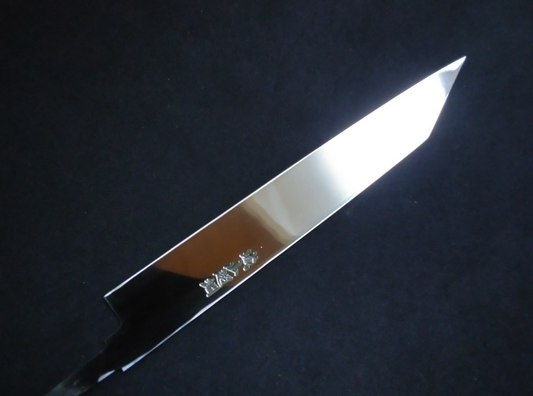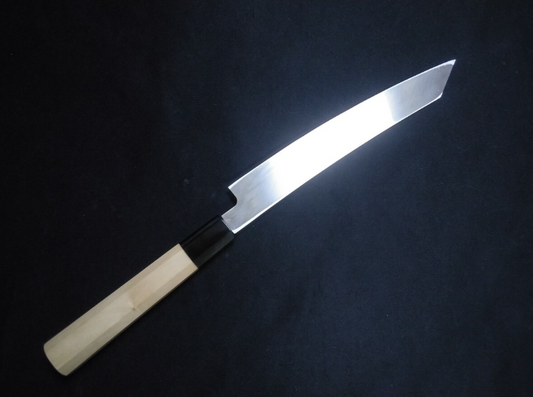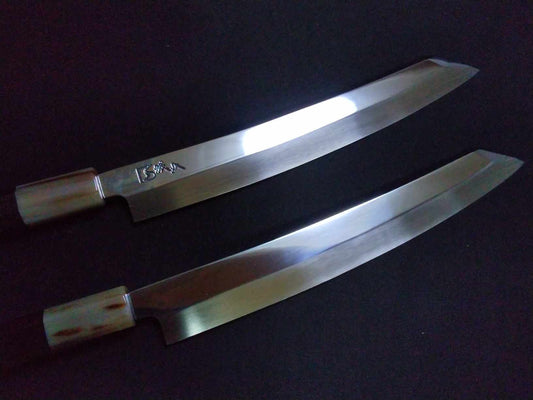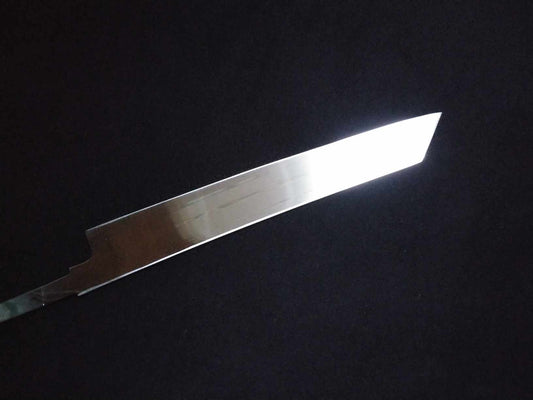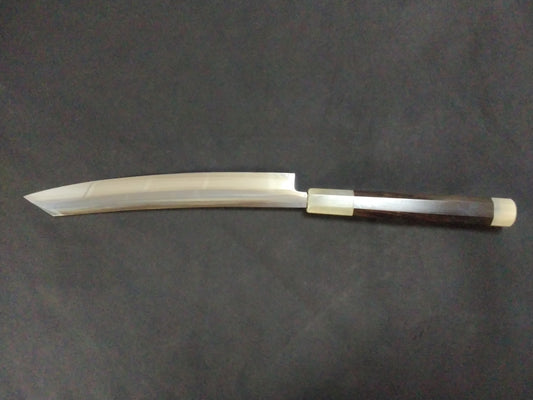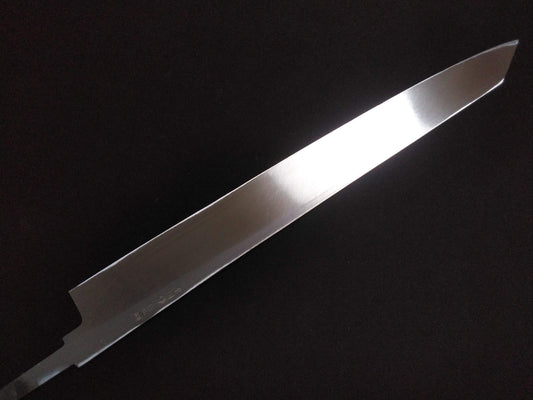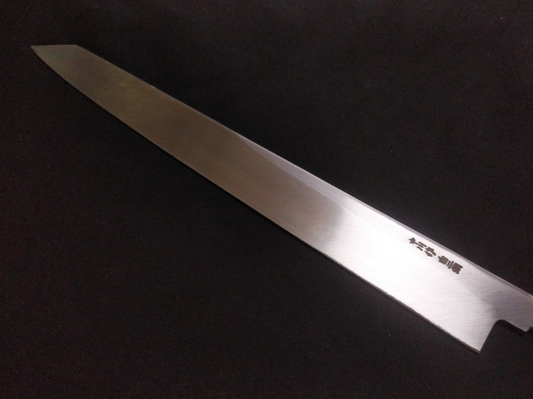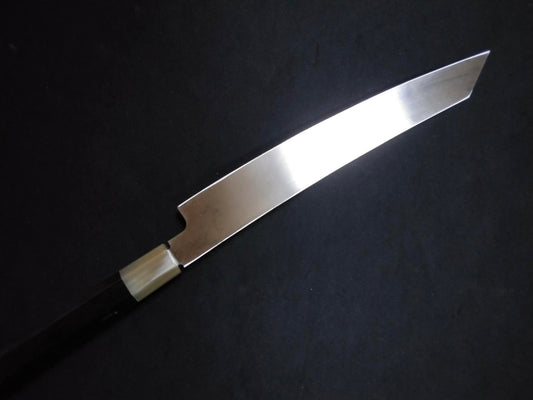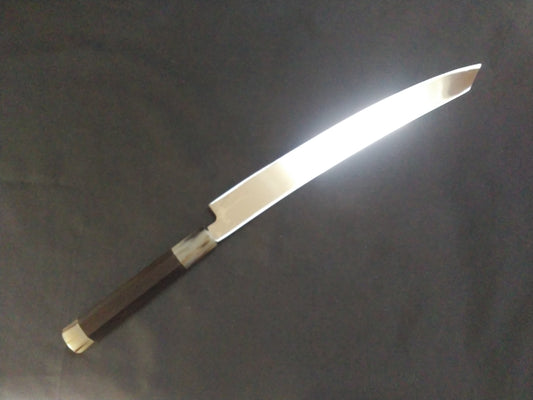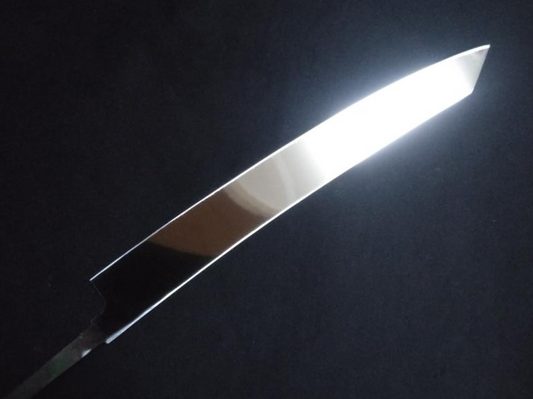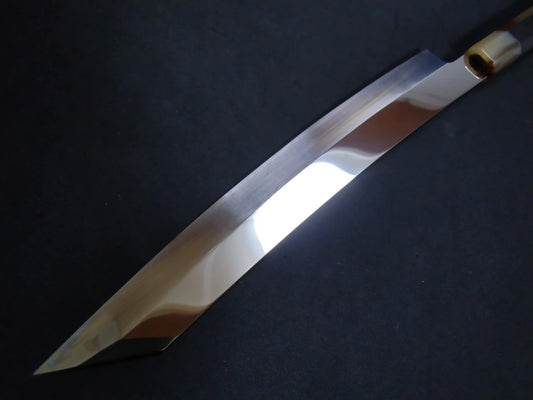
Yanagiba (Kiritsuke)
-
Yanagiba Meets Bold Geometry — The Kiritsuke
A classic sashimi knife reimagined with a striking angled tip for power, precision, and style in every slice.
-
Yanagiba(Kiritsuke) Japanese Knife Collection
-
Ginsan Yanagiba(Kiritsuke) 225mm -Mirror Polished(both sides)
Regular price $412.00 CADRegular priceUnit price / per$0.00 CADSale price $412.00 CADSold out -
Super Steel (Honyaki) Yanagiba(Kiritsuke) 210mm-Kido Finishing
Regular price $420.00 CADRegular priceUnit price / per$0.00 CADSale price $420.00 CAD -
Super Steel (Honyaki) Yanagiba(Kiritsuke) 210mm-Mirror Polished(one side)
Regular price $433.00 CADRegular priceUnit price / per$0.00 CADSale price $433.00 CAD -
Super Steel (Honyaki) Yanagiba(Kiritsuke) 210mm-Mirror Polished(both sides)
Regular price $443.00 CADRegular priceUnit price / per$0.00 CADSale price $443.00 CAD -
Super Steel (Honyaki) Yanagiba(Kiritsuke) 210mm-Mirror Polished(both sides)
Regular price $469.00 CADRegular priceUnit price / per$0.00 CADSale price $469.00 CADSold out -
White Steel #2 Yanagiba (Kiritsuke) 300mm-Mirror Polished(one side)
Regular price $469.00 CADRegular priceUnit price / per$0.00 CADSale price $469.00 CAD -
Ginsan Yanagiba(Kiritsuke) 270mm -Mirror Polished(both sides)
Regular price $480.00 CADRegular priceUnit price / per$0.00 CADSale price $480.00 CAD -
Blue Steel #2 Yanagiba(Kiritsuke) 270mm-Mirror Polished(one side)
Regular price $517.00 CADRegular priceUnit price / per$0.00 CADSale price $517.00 CADSold out -
White Steel #2 Yanagiba (Kiritsuke) 330mm-Mirror Polished(one side)
Regular price $530.00 CADRegular priceUnit price / per$0.00 CADSale price $530.00 CAD -
Blue Steel #2 Yanagiba(Kiritsuke) 330mm-Mirror Polished(one side)
Regular price $600.00 CADRegular priceUnit price / per$0.00 CADSale price $600.00 CADSold out -
Blue Steel #2 Damascus Yanagiba(Kiritsuke) 270mm- Mirror Polished Blur Finish
Regular price $700.00 CADRegular priceUnit price / per$460.00 CADSale price $700.00 CADSold out -
Super Steel (Honyaki) Yanagiba(Kiritsuke) 270mm-Mirror Polished(one side)
Regular price $736.00 CADRegular priceUnit price / per$0.00 CADSale price $736.00 CADSold out -
Ginsan Damascus Yanagiba(Kiritsuke) 270mm -Mirror Polished(both sides)
Regular price $740.00 CADRegular priceUnit price / per$0.00 CADSale price $740.00 CADSold out -
Super Steel (Honyaki) Yanagiba(Kiritsuke) 300mm-Mirror Polished(both sides)
Regular price $808.00 CADRegular priceUnit price / per$0.00 CADSale price $808.00 CAD -
Ginsan Damascus Yanagiba (Kiritsuke) 300mm -Mirror Polished(both sides)
Regular price $810.00 CADRegular priceUnit price / per$0.00 CADSale price $810.00 CAD -
Super Steel (Honyaki) Yanagiba(Kiritsuke) 270mm-Mirror Polished(both sides)
Regular price $816.00 CADRegular priceUnit price / per$0.00 CADSale price $816.00 CAD
KIREAJI's Three Promises to You
-

1. Forged in the Legacy of Sakai
From Sakai City—Japan’s renowned birthplace of professional kitchen knives—each blade is crafted by master artisans with over six centuries of tradition. Perfectly balanced, enduringly sharp, and exquisitely finished, every cut carries the soul of true craftsmanship.
-

2. Thoughtful Care for Everyday Use
Every knife includes a hand-fitted magnolia saya for safe storage. Upon request, we offer a complimentary Honbazuke final hand sharpening—giving you a precise, ready-to-use edge from day one.
-

3. A Partnership for a Lifetime
A KIREAJI knife is more than a tool—it is a lifelong companion. With our bespoke paid aftercare services, we preserve its edge and beauty, ensuring it remains as precise and dependable as the day it first met your hand.
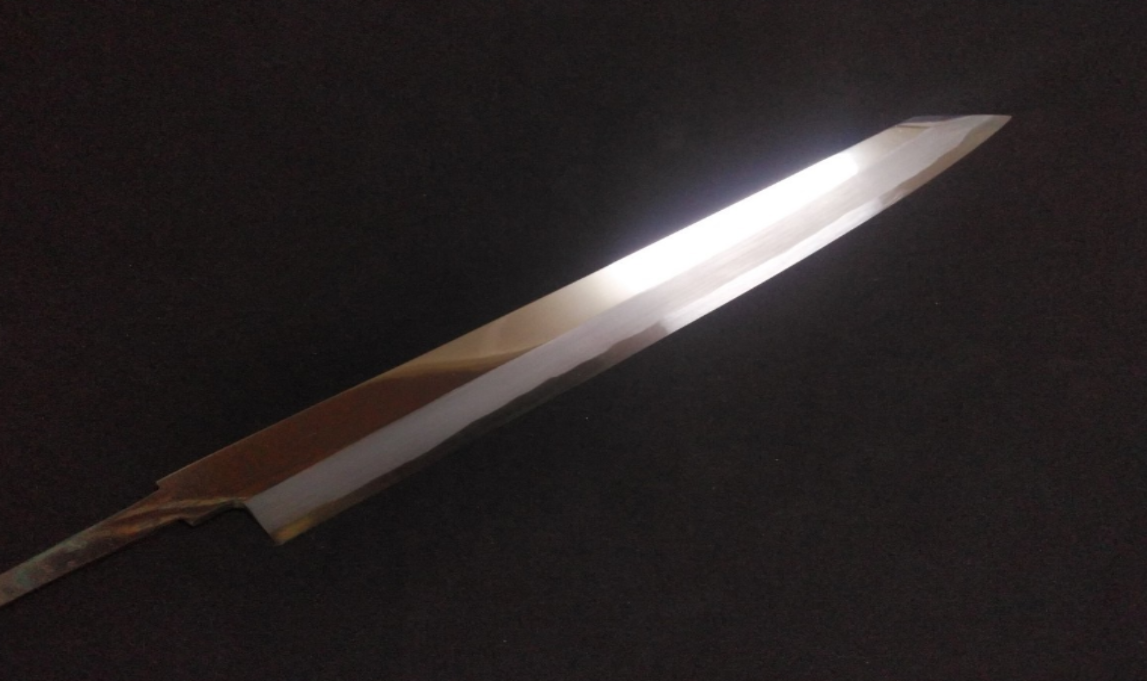
Why Many Product Photos Show Only the Blade
At KIREAJI, every knife is made to order in Sakai, Japan. Photos show the blade before the handle is attached, allowing artisans to perfect the balance and edge for your specific order. Your knife arrives fully finished — tailored just for you.

Global Delivery from Sakai
Across the world, discerning cooks seek authentic Japanese knives from Sakai — Japan’s legendary knife-making city with over 600 years of tradition.
At KIREAJI, we work alongside master artisans in Sakai to fulfill that desire, shipping genuine handcrafted knives directly from the workshop to kitchens worldwide.
Yanagiba (Kiritsuke)
-
-
When it comes to traditional Japanese sashimi knives, the Yanagiba is the timeless classic—sleek, elegant, and beloved by chefs for centuries. Its bolder sibling, the Yanagiba (Kiritsuke), takes tradition and gives it a dramatic twist with a striking angled tip. Both are exceptional tools, but each speaks to a different style of cutting, cooking, and even personality.
-
Yanagiba – The Classic Choice
-

Shaped like a willow leaf, the Yanagiba’s long, slender blade features a gentle curve from heel to tip—perfect for the pull-cut technique that creates clean, glistening slices of sashimi. Its smooth glide through fish makes it a favorite for both professionals and serious home cooks. Easy to sharpen and balanced in hand, the Yanagiba embodies the elegance of Japanese precision.
-
Yanagiba (Kiritsuke) – Bold Lines, Powerful Presence
-

The Yanagiba (Kiritsuke) commands attention with its distinctive angled tip and thicker, heavier blade. This extra weight can add stability but also creates more resistance, demanding greater skill to master. Its straighter edge excels at certain slicing techniques, and the blade’s sharp tip—while visually striking—requires careful maintenance to preserve its shape.
-
Price & Selection Tips
Yanagiba (Kiritsuke) knives are generally more expensive than standard Yanagiba of the same length, as their design requires a larger steel billet and more shaping. Choosing between them depends on your cutting style, how much you value tip precision, and your budget.
For most chefs, the Yanagiba offers versatility and ease of use. The Yanagiba (Kiritsuke) appeals to those who want a statement piece—something that reflects both skill and individuality.
KIREAJI: Born from Authenticity, Built on Purpose
-

With its angled tip and heavier profile, the Kiritsuke Yanagiba offers a bold cutting experience, reflecting both technical skill and artistic individuality.
-
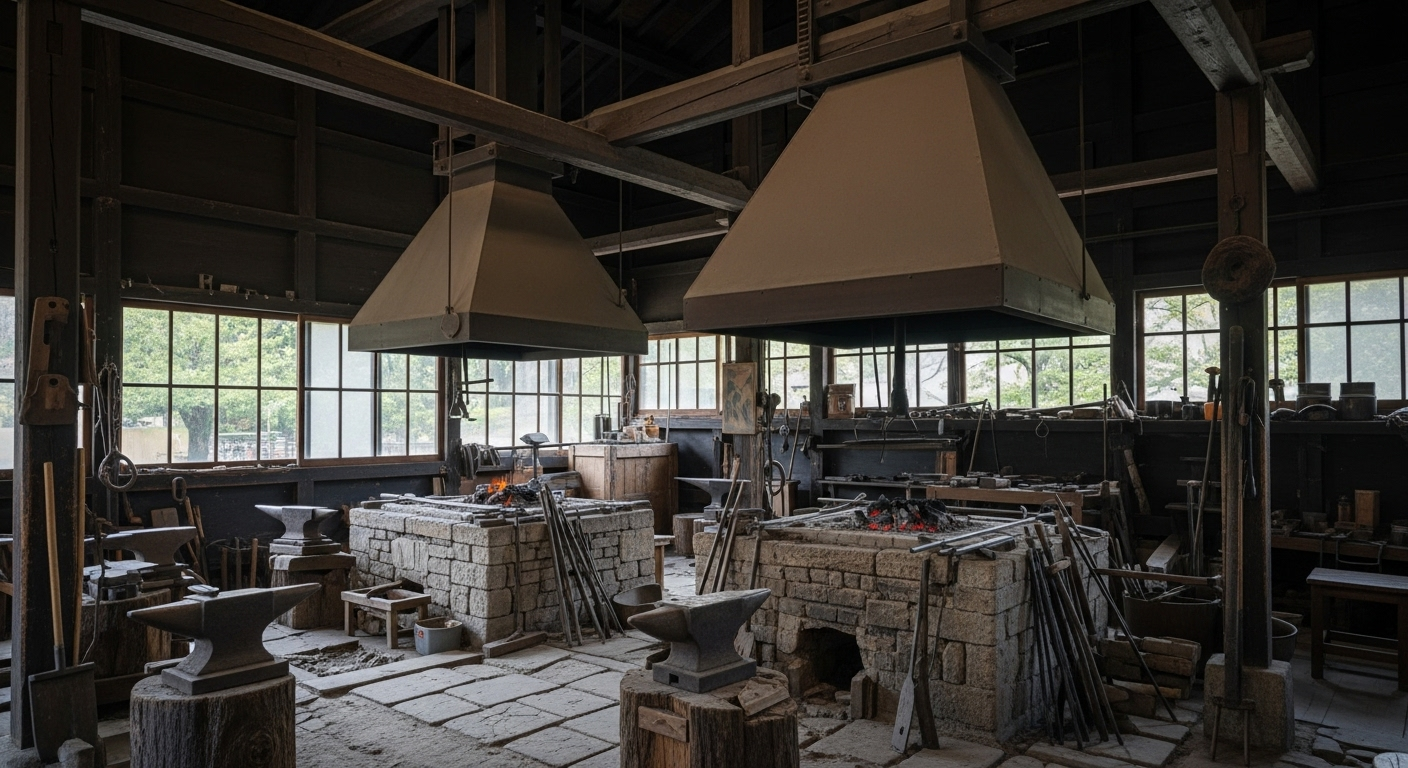
FAQ About Yanagiba(Kiritsuke)
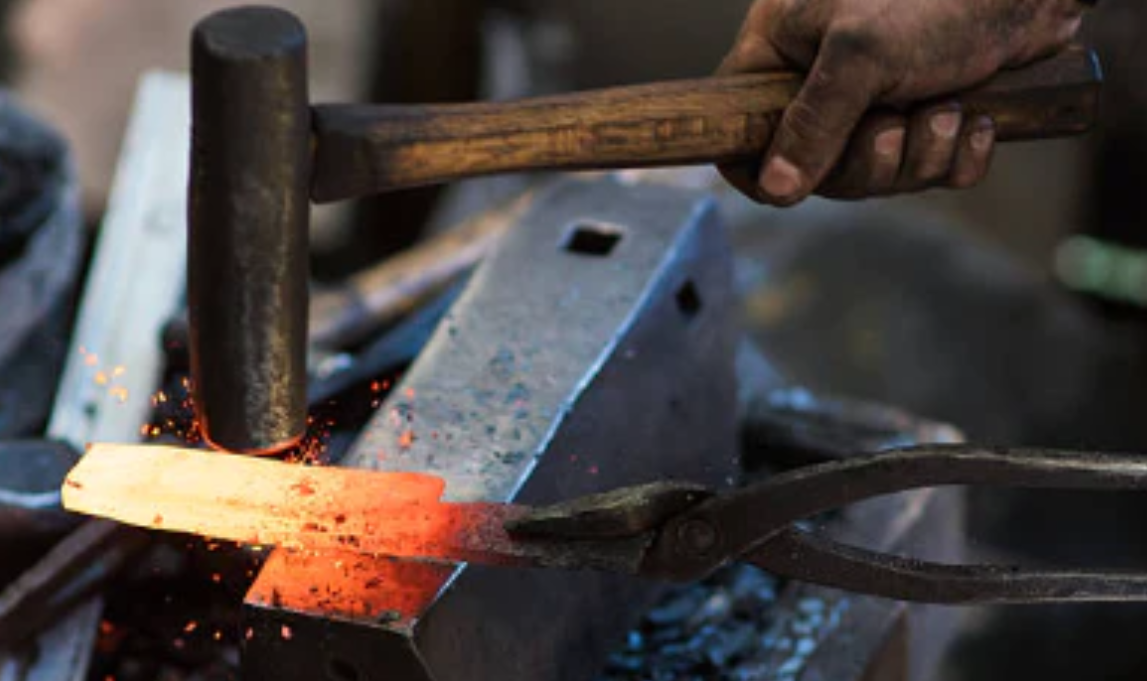
Q1. What is a Yanagiba (Kiritsuke)?
The Yanagiba (Kiritsuke) is a modern variation of the traditional Japanese Yanagiba, distinguished by its angled, chisel-like tip. While it retains the exceptional slicing ability of the classic Yanagiba for sashimi, its unique tip design also makes it suitable for decorative cuts and detailed knife work. This combination of precision and versatility has made it a popular choice among professional chefs.
Q2. How is it different from a traditional Yanagiba?
The main difference lies in the tip design. A traditional Yanagiba has a slender, slightly curved pointed tip, ideal for straightforward sashimi slicing. The Kiritsuke tip, however, is angular and robust, providing more stability and control for delicate garnishing, precise cuts, and even light chopping. This makes the Kiritsuke version more versatile, expanding its role beyond sashimi preparation.
Q3. Can I use a Yanagiba (Kiritsuke) to cut meat?
Yes, but with limitations. Like the standard Yanagiba, the Kiritsuke is primarily intended for slicing raw fish. It can handle thin slices of boneless, tender meat such as beef carpaccio, but it is not suited for tougher cuts, sinewy textures, or bone-in meat. For heavier meat preparation, a Western chef’s knife or a Japanese deba knife is more practical.
04. How is it different from a Yanagiba (Sakimaru)?
The Sakimaru Yanagiba has a rounded, upward-curved tip, favored in kaiseki and ceremonial cuisine for its graceful aesthetic. The Kiritsuke Yanagiba, by contrast, has a sharper, more angular tip that combines visual drama with functional versatility. This makes it particularly popular in open kitchens and chef’s counters, where performance and presentation go hand in hand.
Q5. Who should choose a Yanagiba (Kiritsuke)?
This knife is best suited for chefs and experienced users who want a Yanagiba with added versatility. It appeals to those who value both precision slicing for sashimi and the ability to perform detailed decorative cuts, while also appreciating the dramatic appearance of the blade.
Q6. Is the Kiritsuke Yanagiba difficult to master?
Yes. Like all single-bevel Japanese knives, it requires technique and practice to use effectively. The angled tip adds versatility but also demands precision in handling and sharpening. For beginners, it can feel challenging, but for dedicated users it offers a rewarding combination of function and artistry.

A Razor-Sharp Knife and the Birth of Sashimi
Sashimi is more than raw fish—it is tradition, art, and precision, a cuisine that could only have emerged in Japan. At its heart lies the Japanese knife, whose ultra-sharp edge made this culinary culture possible. This article explores how the evolution of these blades shaped sashimi, and why precision cutting remains its very foundation.

What is a Japanese fish knife called?
Learn about the Yanagiba, Japan's iconic fish knife, and how its design ensures precision in sushi and sashimi preparation. Discover its unique features, care tips, and why it's a must-have for any seafood enthusiast.
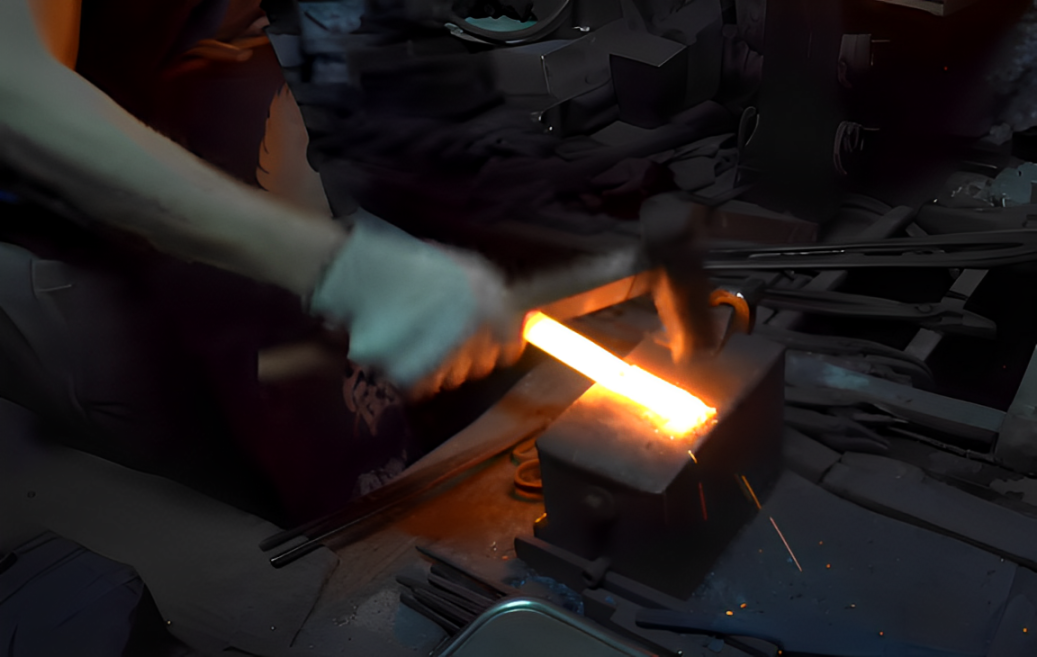
The Soul of Craftsmanship
-
The Timeless Craft of Yanagiba Knives — A Chef’s Trusted Partner
A Yanagiba knife is more than just a tool—it is a mirror of a chef’s skill, individuality, and dedication. Choosing the right shape is not merely about preference; it reflects years of training, discipline, and the traditions passed down from master to apprentice.
-
The kiritsuke shape, in particular, enhances precision when filleting fish or preparing sashimi, capturing the unique style of each chef. This design is not just about aesthetics—it embodies efficiency, elegance, and functionality in every cut.
-
Each Yanagiba we craft is born from meticulous attention to detail, blending centuries-old techniques with the needs of today’s kitchens. From the forging of the steel to the final honing, every step ensures the knife performs at its best in the hands of a skilled chef.
-
Above all, we strive to create knives that empower chefs to fully express their artistry and passion. Supporting their journey with tools they can rely on is not just our mission—it is the pride and soul of Sakai craftsmanship.
How Japanese Knives Are Made: The Sakai Tradition
VIDEO PROVIDED: JAPAN TRADITIONAL CRAFTS AOYAMA SQUARE (YOUTUBE)
-
Sakai Forged Blades — Six Centuries of Unrivaled Craftsmanship
Loved by chefs around the world and trusted by 98% of Japan’s top culinary professionals, Sakai knives are more than tools—they are the living legacy of over 600 years of master craftsmanship.
-
At KIREAJI, we work directly with the Shiroyama Knife Workshop in Sakai, Japan, ensuring every blade is hand-forged, finished to perfection, and shipped straight from the workshop to kitchens across the globe. No middlemen. No mass production. Only authentic, artisan-made knives, crafted to elevate your cooking for a lifetime.


